Click on images to enlarge

habit (Photo: Marie Vitelli)
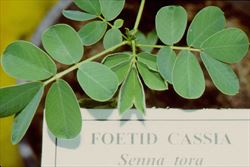
leaves (Photo: Marie Vitelli)
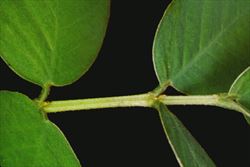
close-up of leaf showing glands (Photo: Marie Vitelli)
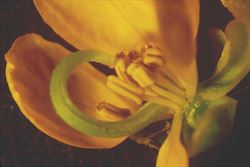
close-up of flower showing anthers (Photo: Marie Vitelli)
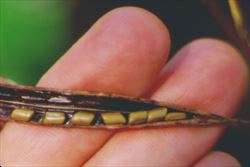
mature seed-pod with seeds (Photo: Marie Vitelli)
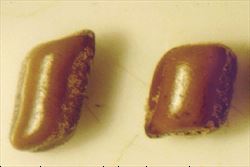
close-up of seeds (Photo: Marie Vitelli)
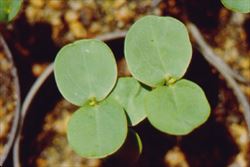
seedlings (Photo: Marie Vitelli)
Scientific Name
Senna tora (L.) Roxb.
Synonyms
Cassia tora L.
Family
Caesalpiniaceae (Queensland, the ACT, Victoria, Tasmania, Western Australia and the Northern Territory)Fabaceae: sub-family Caesalpinioideae (New South Wales)Leguminosae (South Australia)
Common Names
Chinese senna, foetid cassia, Java bean, Java-bean, low senna, peanut weed, sickle senna, sicklepod, sicklepod senns, stinking cassia, wild senna
Origin
The exact native range of this species is obscure, but it is thought to be native to the Indian sub-continent (i.e. India, Bhutan, Nepal, eastern Pakistan, Sri Lanka), southern China, south-eastern Asia (i.e. Cambodia, Laos, Myanmar, Thailand, Vietnam, Indonesia, Malaysia, the Philippines and Papua New Guinea) and parts of western Polynesia (i.e. the Solomon Islands).
Naturalised Distribution
This species has a scattered distribution in the coastal and sub-coastal regions of northern Queensland and the northern parts of the Northern Territory. It has also been recorded in coastal central Queensland.
Also naturalised in other parts of Oceania (i.e. the Cook islands, Fiji, French Polynesia, Guam, Niue, New Caledonia, Western Samoa and Tonga), some parts of the USA (i.e. Michigan and Florida) and in the Mascarenes (i.e. La Réunion).
Habitat
A weed of disturbed sites, waste areas, roadsides, waterways, plantation crops and pastures in wetter tropical and sub-tropical environments.
Habit
A small short-lived (i.e. annual or biennial), upright (i.e. erect), shrub usually growing 50-150 cm tall, but sometimes growing up to 2.5 m in height.
Distinguishing Features
- a small, short-lived, shrub usually growing 50-150 cm tall.
- its compound leaves consist of two to four pairs of rounded-tipped leaflets (10-40 mm long).
- its yellow flowers (about 9 mm across) are borne in pairs in the leaf forks and have five petals.
- its fruit is a slender curved pod (12-25 cm long and 3-6 mm wide) that turns brownish-green as it matures.
- this species gives off a foul odour when damaged.
Stems and Leaves
The branched, sprawling, stems are usually hairless (i.e. glabrous) or sparsely hairy (i.e. puberulent).
The compound (i.e. pinnate) leaves are alternately arranged along the stems and are borne on relatively long stalks (i.e. petioles) 20-45 mm long. These leaves (50-75 mm long) have two to four pairs of leaflets that are egg-shaped in outline with the narrower end attached to the stalk (i.e. obovate). The leaflets (10-55 mm long and 10-35 mm wide) have rounded tips (i.e. obtuse apices) and their margins are lined with tiny hairs (i.e. cilia). There is a small elongated structure (i.e. gland) usually located between each of the lowest two pairs of leaflets (sometimes these glands are only present between the lowest pair of leaflets). The leaves of this species give off a strong unpleasant odour, particularly when damaged or brushed against.
Flowers and Fruit
The yellow flowers are borne on short stalks (i.e. pedicels) 6-10 mm long. These flowers are arranged in pairs in the leaf forks (i.e. axils) and are mostly found near the tips of the branches. Each flower has five sepals, five yellow petals (8-10 mm long) and seven fertile stamens with small anthers (1.5-2.5 mm long). Flowering occurs mostly from late summer through to early winter.
The fruit is a very slender, sickle-shaped (i.e. falcate), pod (12-25 cm long and 2-6 mm wide) that is almost round in cross-section (i.e. cylindrical) and curved downwards. These pods turn brownish-green as they mature and are slightly indented between each of the numerous (20-30) seeds (i.e. the pods are faintly septate). The seeds are striped olive and brown (about 3 mm long), shiny in appearance, and flattened (i.e. compressed) or irregularly shaped (i.e. rhombic-rounded).
Reproduction and Dispersal
This plant reproduces by seed.
These seeds are dispersed by water and animals that eat the fruit (e.g. cattle). They may also be spread as a contaminant of agricultural produce (i.e. fodder and pasture seeds) or in mud sticking to animals, footwear, machinery and vehicles.
Environmental Impact
Java bean (Senna tora) is regarded as an environmental weed in northern Queensland and the Northern Territory.
Legislation
This species is declared under legislation in the following states and territories:
- Queensland: Class 2 - landowners must take all reasonable steps to keep land free of this species (throughout the entire state). It is also illegal to sell a declared plant or its seed in this state.
- Western Australia: P1 - trade, sale or movement into the state prevented, and P2 - to be eradicated where found (throughout the entire state).
Management
For information on the management of this species see the following resources:
- the Biosecurity Queensland Fact Sheet on sicklepods, which is available online at http://www.dpi.qld.gov.au.
Similar Species
Java bean (Senna tora) is very similar to sicklepod (Senna obtusifolia), hairy senna (Senna hirsuta), coffee senna (Senna occidentalis), smooth senna (Senna septemtrionalis) and the native arsenic bush (Senna planitiicola). It is also relatively similar to Easter cassia (Senna pendula var. glabrata) and pepper-leaved senna (Senna barclayana). These species can be distinguished by the following differences:
- Java bean (Senna tora) is a relatively small slender shrub (usually 0.5-2 m tall) that has leaves with a few (2-4) pairs of leaflets. The moderately-sized leaflets (10-40 mm long) are relatively broad (10-35 mm wide) and have rounded tips (i.e. obtuse apices). Its flowers are borne in pairs in the leaf forks and its very elongated (12-25 cm long) pods are almost rounded in cross-section (i.e. cylindrical) and very narrow (2-6 mm wide). These pods are strongly curved downwards (i.e. sickle-shaped) and are mostly hairless (i.e. glabrous). This species also gives off a strong unpleasant smell.
- sicklepod (Senna obtusifolia) is a relatively small slender shrub (usually 0.5-2 m tall) that has leaves with a few (2-3) pairs of leaflets. The relatively large leaflets (17-65 mm long) are relatively broad (15-40 mm wide) and have rounded tips (i.e. obtuse apices). Its flowers are borne in pairs in the leaf forks and the very elongated (6-18 cm long) pods are almost rounded in cross-section (i.e. cylindrical) and very narrow (2-6 mm wide). These pods are strongly curved downwards (i.e. sickle-shaped) and are mostly hairless (i.e. glabrous).
- hairy senna (Senna hirsuta) is a relatively small slender shrub (usually 0.5-2 m tall) that has leaves with several (2-6) pairs of leaflets. These relatively large leaflets (40-105 mm long) are relatively broad (20-40 mm wide) and have pointed tips (i.e. acute apices). Its flowers are borne in small clusters in the leaf forks and its very elongated (10-18 cm long) pods are usually somewhat flattened and very narrow (4-6 mm wide). These pods are slightly-curved downwards and are densely covered in long white hairs (i.e. pubescent).
- coffee senna (Senna occidentalis) is a relatively small slender shrub (usually 0.5-2 m tall) that has leaves with several (3-7) pairs of leaflets. The relatively large leaflets (30-100 mm long) are relatively broad (20-40 mm wide) and have pointed tips (i.e. acute apices). Its flowers are borne in small clusters in the leaf forks and its very elongated (7.5-13 cm long) pods are rounded (i.e. cylindrical) or slightly flattened and relatively thick (6-11 mm wide). These pods are straight or slightly-curved upwards and are mostly hairless (i.e. glabrous).
- smooth senna (Senna septemtrionalis) is a moderately-sized shrub (1-3 m tall) that has leaves with several (3-5) pairs of leaflets. The relatively large leaflets (45-70 mm long) are relatively broad (15-35 mm wide) and have pointed tips (i.e. acute apices). Its flowers are borne in relatively loose somewhat elongated many-flowered clusters (i.e. racemes) and its elongated (6-10.5 cm long) pods are almost rounded in cross-section (i.e. cylindrical) and relatively thick (10-15 mm wide). These pods are straight and mostly hairless (i.e. glabrous).
- arsenic bush (Senna planitiicola) is a relatively small slender shrub (usually 0.5-2 m tall) that has leaves with several (5-7) pairs of leaflets. The moderately-sized leaflets (25-50 mm long) are relatively broad (15-25 mm across) and have somewhat pointed tips (i.e. acute apices). Its flowers are borne in small clusters in the leaf forks and its relatively short (less than 8.5 cm long) pods are almost rounded in cross-section (i.e. cylindrical) and relatively thick (8-11 mm wide). These pods are straight and mostly hairless (i.e. glabrous).
- Easter cassia (Senna pendula var. glabrata) is a moderately-sized shrub (2-4 m tall) that has leaves with several (3-6) pairs of leaflets. The moderately-sized leaflets (20-50 mm long) are relatively broad (10-20 mm wide) with rounded tips (i.e. obtuse apices) and prominent yellowish coloured margins. Its flowers are borne in relatively loose leafy clusters and its elongated (10-20 cm long) pods are almost rounded in cross-section (i.e. cylindrical) and relatively thick (8-12 mm wide). These pods are relatively straight, sometimes have one or more constrictions, and are hairless (i.e. glabrous).
- pepper-leaved senna (Senna barclayana) is a low-growing shrub (usually less than 1 m tall) that has leaves with several (4-10) pairs of leaflets. The moderately-sized leaflets (20-50 mm long) are relatively narrow (4-15 mm wide) and have pointed tips (i.e. acute apices). Its flowers are borne in small clusters in the leaf forks and its relatively short (3-7 cm long) pods are almost rounded in cross-section (i.e. cylindrical) and relatively thick (6-9 mm wide). These pods are straight and hairless (i.e. glabrous).
There are many other native sennas (Senna spp.) that are also relatively similar to Java bean (Senna tora). However, these species generally have thicker pods and ten fertile stamens in each flower.

